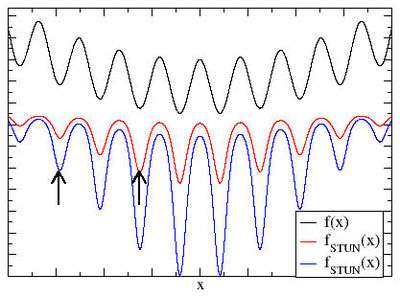Stochastic tunneling
In numerical analysis, stochastic tunneling (STUN) is an approach to global optimization based on the Monte Carlo method-sampling of the function to be objective minimized in which the function is nonlinearly transformed to allow for easier tunneling among regions containing function minima. Easier tunneling allows for faster exploration of sample space and faster convergence to a good solution.
Idea

Monte Carlo method-based optimization techniques sample the objective function by randomly "hopping" from the current solution vector to another with a difference in the function value of . The acceptance probability of such a trial jump is in most cases chosen to be (Metropolis criterion) with an appropriate parameter .
The general idea of STUN is to circumvent the slow dynamics of ill-shaped energy functions that one encounters for example in spin glasses by tunneling through such barriers.
This goal is achieved by Monte Carlo sampling of a transformed function that lacks this slow dynamics. In the "standard-form" the transformation reads where is the lowest function value found so far. This transformation preserves the loci of the minima.
is then used in place of in the original algorithm giving a new acceptance probability of
The effect of such a transformation is shown in the graph.
Dynamically adaptive stochastic tunneling
A variation on always tunneling is to do so only when trapped at a local minimum. is then adjusted to tunnel out of the minimum and pursue a more globally optimum solution. Detrended fluctuation analysis is the recommended way of determining if trapped at a local minimum.
Other approaches
References
- K. Hamacher (2006). "Adaptation in Stochastic Tunneling Global Optimization of Complex Potential Energy Landscapes". Europhys. Lett. 74 (6): 944–950. Bibcode:2006EL.....74..944H. doi:10.1209/epl/i2006-10058-0.
- K. Hamacher & W. Wenzel (1999). "The Scaling Behaviour of Stochastic Minimization Algorithms in a Perfect Funnel Landscape". Phys. Rev. E. 59 (1): 938–941. arXiv:physics/9810035. Bibcode:1999PhRvE..59..938H. doi:10.1103/PhysRevE.59.938.
- W. Wenzel & K. Hamacher (1999). "A Stochastic tunneling approach for global minimization". Phys. Rev. Lett. 82 (15): 3003–3007. arXiv:physics/9903008. Bibcode:1999PhRvL..82.3003W. doi:10.1103/PhysRevLett.82.3003.
- Nicholas Metropolis, Arianna W. Rosenbluth, Marshall N. Rosenbluth, Augusta H. Teller and Edward Teller (June 1953). "Equation of State Calculations by Fast Computing Machines" (PDF). The Journal of Chemical Physics. 21 (6): 1087–1092. Bibcode:1953JChPh..21.1087M. doi:10.1063/1.1699114.CS1 maint: multiple names: authors list (link)
- Mingjie Lin (December 2010). "Improving FPGA Placement with Dynamically Adaptive Stochastic Tunneling". IEEE Transactions on Computer-Aided Design of Integrated Circuits and Systems. 29 (12): 1858–1869. doi:10.1109/tcad.2010.2061670.